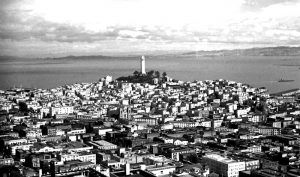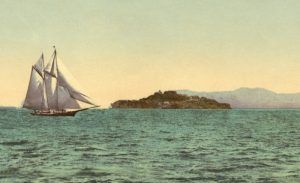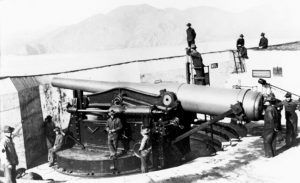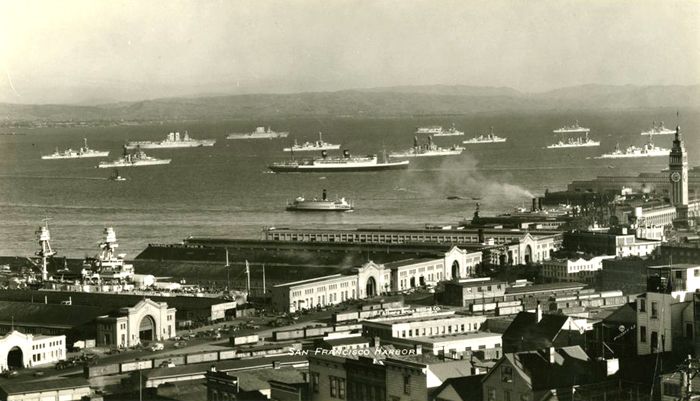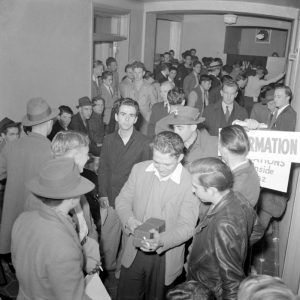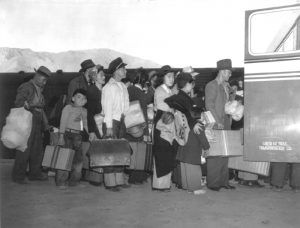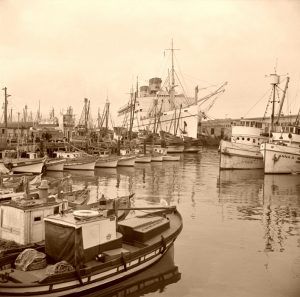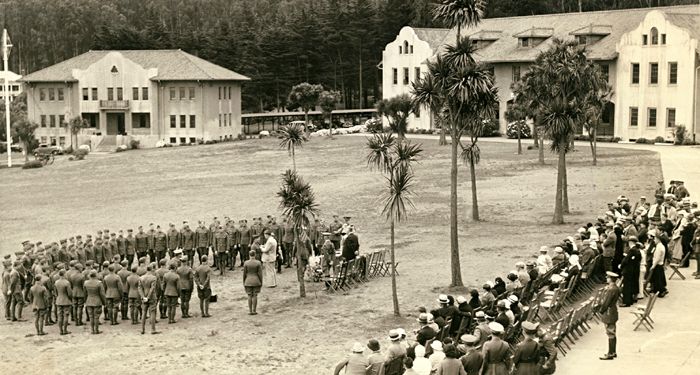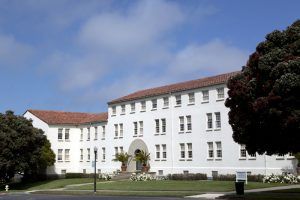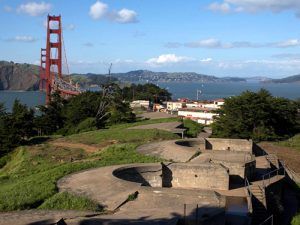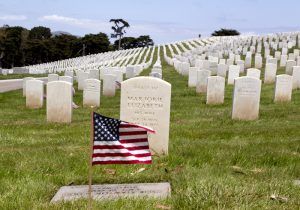During World War II, the San Francisco Bay Area became America’s “Arsenal of Democracy,” causing so many dramatic changes in the Bay Area that the war years came to be known as the “Second Gold Rush.” During that time, the area served as the arsenal’s shipyard, coastal fortress, and a pipeline to the Pacific.
World War II dominated the social, economic, and political landscapes of the mid-20th century, setting in motion momentous events that still shape the world we live in today. That wartime era irrevocably altered the communities that ring the San Francisco Bay. They still bear visible marks in the remains of military bases and coastal defense fortifications, ships and shipbuilding facilities, worker housing, and other buildings.
Beginning during the California Gold Rush in the 1850s, the U.S. Army had been continually constructing, expanding, and modernizing harbor defenses surrounding the Golden Gate. It intended to keep an enemy from capturing the port with its strategic military and industrial sites. In the early years, French and British fleets were most feared by American planners. Prominent masonry forts armed with scores of smoothbore cannons were constructed at Fort Point in the Presidio de San Francisco and on Alcatraz Island in the middle of the bay. During the Civil War and the following years, additional masonry and earthwork fortifications were constructed along both shores of the Golden Gate straits. Well-preserved examples of these semipermanent fortifications can still be seen at Battery East in the Presidio and Battery Cavallo at Fort Baker.
In the 1890s, the army began a major modernization of the Nation’s coastal fortifications. Because of its strategic importance, San Francisco Bay was given the number two priority behind New York Harbor. This rearmament project resulted in the wholesale scrapping of smoothbore artillery and the introduction of modern breech-loading artillery protected in concrete gun emplacements. Construction of these fixed defenses had a dual role: first, the improved fortifications made the Nation’s ports much more secure and ready to deal with the threat from modern armored warships; secondly, the strong shore defenses freed up the U.S. naval forces from their reluctant role as “floating coastal forts.” This strategic change allowed our navy to freely sail the globe and extend our military presence and U.S. influence to foreign countries. By 1910, nearly 120 coast artillery guns were mounted in the Harbor Defenses of San Francisco. Ranging in size from three-inch rapid-fire weapons to 12-inch long-range guns, these fortifications were designed to meet the threat of any size vessel, from a small patrol boat to a heavily armored battleship. These new weapons and fortifications would form the backbone of San Francisco’s coastal defenses until after the end of World War II.
As Europe headed deeper towards war in the 1930s, isolationist America reluctantly began upgrading its coastal fortifications. In San Francisco, this program led to the construction of two batteries mounting the largest guns then in American arsenals: 16-inch caliber rifles mounted on high-elevation carriages, capable of firing 2,100-pound projectiles nearly 26 miles. To protect the weapons against the growing threat of aerial bombardment, each battery of two guns was constructed as an underground fortification with the guns aiming out from the sides of heavily camouflaged, manmade hills. Up to 20 feet of overhead concrete and earth cover protected the guns, along with a labyrinth of connecting corridors, ammunition magazines, power plants, crew spaces, and various storage rooms. Antiaircraft guns were concentrated nearby to protect the new batteries and to ward off attacking enemy aircraft.
Preparations for mobilization to create “Fortress San Francisco” were massive. Forts Baker, Barry, and Cronkhite ringed the tip of Marin County while Fort Point mounted guard on the Golden Gate Straits. Inside the bay were several bases, including Fort Mason, the principal Pacific Port of Embarkation, the Presidio, Fort Miley, Hamilton Field, and Moffett Field. Completed in 1940, Battery Davis at Fort Funston and Battery Townsley at Fort Cronkhite were the prototypes for all subsequent fortification designs adopted by the U.S. Army. On the eve of World War II, these two batteries formed the state-of-the-art defenses of San Francisco and the entire United States.
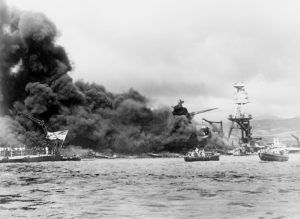
The United States entered World War II after the bombing of Pearl Harbor, Hawaii, on December 7, 1941.
On December 7, 1941, the Harbor Defenses of San Francisco Bay comprised a mixture of modern batteries and aging, but still potent, coast artillery emplacements constructed at the turn-of-the-century; mobile tractor-drawn field artillery and antiaircraft guns; and the underwater minefields that still protected the shipping channels. Manning these defenses were an assemblage of “old army” regulars from the Sixth Coast Artillery Regiment, newly-formed units such as the 18th, 54th, and 56th Coast Artillery Regiments, and National Guard Regiments from as far away as Minnesota and Texas. When news reached San Francisco of the Japanese attack on Pearl Harbor, all off-duty personnel were recalled to their units, and the harbor defenses were put on full alert. Soldiers moved out of their barracks and into the batteries and began filling sandbags, stringing barbed wire, and constructing beach defenses at a fevered pace. Up and down the coast, observers in tiny concrete observation posts scanned the horizon for the approach of a Japanese fleet that would never come.
The San Francisco Bay Area’s major contribution to victory during World War II was shipbuilding. During the war, men and women working in Bay Area shipyards, like Kaiser’s Richmond Shipyard Number Three, built 1,400 vessels — a ship a day, on average. Mare Island Naval Shipyard provided well-established repair and shipbuilding facilities. The converted Richmond Ford Motor Company Assembly Plant prepared tanks for shipment overseas to the Pacific War, and the Benicia Arsenal manufactured the munitions for these and other weapons. During World War II, tens of thousands of Bay Area women challenged common perceptions about their capabilities and, for the first time, were faced with the problems of being working parents — – finding daycare and housing. These historic places remain today as an indelible imprint of this time and remind us of the dramatic changes brought on by the Bay Area’s participation in World War II.
Three months after the bombing of Pearl Harbor in December 1941, President Franklin Roosevelt issued Executive Order 9066, ordering the relocation of Japanese Americans living in coastal areas, who were at the time considered a security risk. In the following weeks, local newspapers carried almost daily reports of proclamations, plans, and restrictions on their civil liberties. Japanese internees were first transported to one of 13 “Assembly” centers throughout the state and then to permanent camps inland. Nearly 100,000 Californians of Japanese descent were removed from their homes and livelihoods for incarceration during the war until 1945.
A historian once described San Francisco during World War II as “a giant cannon aimed at the Pacific,” likening the millions of tons of cargo and munitions coming out of the port to projectiles sent against the Japanese military forces. To protect the all-important entrance to the harbor, the Golden Gate, and its famous bridge, the U.S. Army and Navy arrayed a vast network of coastal fortifications, underwater minefields, antiaircraft guns, radars, searchlights, observation posts, and patrol aircraft. Today, the still-impressive remains of that network can be seen at many locations in the Golden Gate National Recreation Area.
As the days and weeks progressed, the initial fear of imminent invasion settled into a long-term commitment to defend the harbor by every means possible. Mobile antiaircraft guns, searchlights, and radars were positioned on virtually every hill and knoll overlooking the Golden Gate. The U.S. Navy stretched an antisubmarine net across the inner harbor extending from the Marina in San Francisco to Sausalito in Marin and stationed a navy tugboat to open and close the net to allow friendly shipping to pass. Soldiers assigned to the fortifications and observation stations constructed extensive earthwork trenches on the hillsides near their batteries and, in some cases, tunneled into hillsides to construct unauthorized but comfortable underground quarters. Everywhere, camouflage paint was daubed on concrete batteries and wood barracks, and acres of camouflage nets were stretched over fortifications to obscure their presence from high-flying enemy planes. Overhead, navy blimps armed with depth charges patrolled offshore waters searching for Japanese submarines but only attacked the occasional unfortunate whale.
The command center for all these activities was an underground facility covertly constructed at Fort Winfield Scott in the Presidio of San Francisco and dubbed the Harbor Defense Command Post/Harbor Entrance Command Post. This command post was little discussed, but its role was crucial, for here inside the bombproof command center, army and navy senior staff coordinated their resources both to defend the bay against enemy sea or air attacks and also to track and coordinate all shipping traffic in and out of the Golden Gate.
No enemy hhadever attacked San Francisco, and by 1944 it was evident to the army-navy commanders that invasion was a far distant likelihood. The soldiers of the harbor defenses were needed on battlefronts elsewhere, and starting that year, the Harbor Defense Command began to phase out its operations. With the signing of the peace treaty with Japan in 1945, the army reevaluated its need for static defenses, especially in light of a new age of long-range bombers and nuclear weapons. The phase-out was speeded up, and by 1948 the last of the army’s San Francisco coastal artillery fortifications had been scrapped.
Today, the remains of “Fortress San Francisco” can still be found throughout the Golden Gate National Recreation Area. In the Presidio of San Francisco, Battery Lowell A. Chamberlin at Baker Beach displays a rare six-inch rifle on a 1903 disappearing carriage. An adjacent display gallery tells the story of the bay’s harbor defenses. Fort Point, a veteran of the Civil War, was pressed into use during World War II for a battery of three-inch guns, and its museum also tells the story of the harbor defenses of San Francisco. At Forts Funston and Cronkhite, the empty casemates of Batteries Davis and Townsley can still be explored, although their udarkinteriors are closed for safety reasons. Below Battery Townsley at Rodeo Beach in Fort Cronkhite, visitors can see the preserved 1940s “mobilization barracks” complex where the coast artillery soldiers lived.
Across from Fort Cronkhite is Fort Barry, the site of several 1900-era gun batteries that were armed during World War II. Many of these batteries still display remnants of their green-and-ochre camouflage schemes applied shortly after Pearl Harbor. Also at Fort Barry is Battery Elmer J. Wallace, a 12-inch battery that was extensively rebuilt with an overhead cover during World War II and now appears much like a scaled-down version of Batteries Davis and Townsley.
Throughout Golden Gate National Recreation Area are dozens of observation posts used by coast artillery troops. Officially known as “base end stations,” these tiny structures housed a crew of observers whose job was to search the horizon for the approach of enemy ships and, in the event of an attack, direct the gunfire of the big guns through telephone communication. These stations stretch along the San Francisco coastline from Point Reyes in the north to Half Moon Bay in the south. Some of the best examples can be found at Fort Cronkhite above Battery Townsley, Fort Barry near Battery Mendell, and Fort Funston near Battery Davis.
The land is perhaps the most visible remnant of the army’s defensive system. In their efforts to construct ever more far-flung fortifications, the U.S. Army purchased large tracts of land overlooking the Golden Gate and its approaches. Kept out of private hands, these lands eventually formed an unintentional but invaluable “green belt” around the entrance to San Francisco Bay. In 1972, Congress created the Golden Gate National Recreation Area and included these lands within its boundaries. Today, the former World War II harbor defense posts of Forts Funston, Miley, Winfield Scott, Baker, Barry, and Cronkhite provide some of the most spectacular and unspoiled open space surrounding any American city. Combined with the earlier military posts of Alcatraz Island, Angel Island, Fort Mason, and the Presidio of San Francisco, the U.S. Army handed down a gift of urban parkland truly unrivaled anywhere to today’s generation.
People from across the Nation came to the Bay Area to help the war effort, many of whom stayed there after the war ended. As a result, they enriched the area communities with new cultures and traditions.
Compiled and edited by Kathy Alexander/Legends of America, updated January 2023.
Also See:
Golden Gate National Recreation Area
Source: National Park Service – WWII in the San Francisco Bay Area


